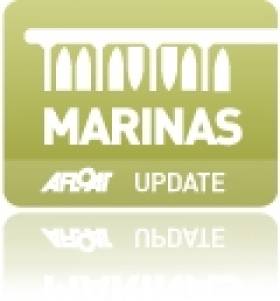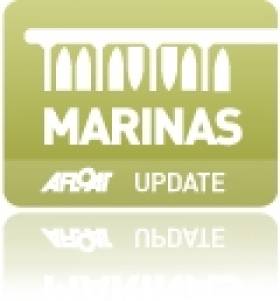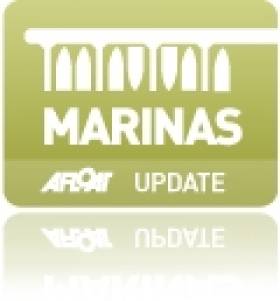Displaying items by tag: Irish Marinas
Howth Marina. Yacht and Boat Berths & Storage in Dublin
Howth Marina is located on the north coast of the rugged peninsula that forms the northern side of Dublin Bay. Howth Marina is ideally situated for north or south-bound traffic in the Irish Sea. Well sheltered in all winds, it can be entered at any state of the tide. Overlooking the marina is Howth Yacht Club, which has in recent years been expanded and is now said to be the largest yacht club in Ireland. With good road and rail links, Howth is in easy reach of Dublin airport and ferry terminal, making it an obvious choice for crew changeovers.
Howth Marina, Harbour Road, Howth, Co. Dublin
Tel: 00353 1 839 2777 Fax: 00353 1 839 2430
Email: [email protected]
VHF: Ch M, 80
Access H24
Arklow Marina. Yacht and Boat Berths & Storage in Dublin
Arklow is a popular fishing port and seaside town situated at the mouth of the River Avoca, 16 miles south of Wicklow and 11 miles north east of Gorey. The town is ideally placed for visiting the many beauty spots of County Wicklow including Glenmalure, Glendalough and Clara Lara, Avoca (Ballykissangel). Arklow Marina is on the north bank of the river just upstream of the commercial quays, with 42 berths in an inner harbour and 30 berths on pontoons outside the marina entrance. Vessels over 14m LOA should moor on the river pontoons.
Arklow Marina, North Quay, Arklow, Co. Wicklow
Tel: 00353 402 39901 Fax: 00353 402 39902
Mobile: 087 2375189
Email: [email protected]
VHF: Ch 12
Access: H24
Kilmore Quay Marina. Yacht & Boat Berths & Storage in Wexford
Kilmore Quay is located in the south east corner of Ireland. A small fishing village situated approximately 14 miles from the town of Wexford and 12 miles from Rosslare ferry port. Its 55 berthed marina, offers shelter from the elements as well as various on shore facilities. Kilmore Quay is a regular port of call for many cruising yachtsmen. With several nearby areas of either historical or natural significance accessible using local bike hire, Kilmore Quay is renowned for its 'green' approach to the environment.
Kilmore Quay, Wexford, Ireland
Tel: 00353 53 912 9955 Fax: 00353 53 912 9915
Email: [email protected]
www.wexford.ie
Salve Marina. Yacht & Boat Berths & Storage in Cork
Crosshaven provides a gateway to Ireland's stunning south and south west coasts. Offering a variety of activities to suit all people, it's rocky coves and quiet beaches stretch from Graball to Church Bay and from Fennell's Bay to nearby Myrtleville. Besides a selection of craft shops selling locally produced arts and crafts, there are plenty of pubs, restaurants and takeaways to suit even the most discerning tastes. Lying within a few hundred metres of the village centre is Salve Marine. Salve marina accomodates yachts up to 43m LOA with draughts of up to 4m. It has comprehensive services ranging from engineering and welding facilities to hull and rigging repairs.
Salve Marine, Crosshaven, Co. Cork
Tel: 00353 214 831 145 Fax: 00353 214 831 747
Email: [email protected]
VHF: Ch M
Access H24
Waterford City Marina. Yacht & Boat Berths & Storage in Waterford
Waterford City is famous for its connections with Waterford Crystal, manufactured in the city centre. Waterford is the capital of the south east region of Ireland. As a major city, it benefits from good rail links with Dublin, and Limerick, a regional airport with daily flights to Britain and an extensive bus service to surrounding towns and villages. The marina is found on the banks of the River Suir, in the heart of this historic Viking city dating back to the ninth century. Yachtsmen can make the most of Waterford's wide range of shops, restaurants and bars without having to walk too far from their boats. With 150 fully serviced berths and first rate security, Waterford City Marina now provides shower, toilet and laundry facilities in its new reception building.
Waterford City Marina, Waterford.
Tel: 00353 87 238 4944 Fax: 00353 51 849763
Email: [email protected]
VHF: Ch 12
Access H24
Crosshaven Boatyard Marina. Yacht & Boat Berths & Storage in Cork
Crosshaven Boatyard is one of three marinas in Crosshaven. The boatyard was founded in 1950 and originally made its name from the construction of some of the most world-renowned yachts, including Gypsy Moth and Denis Doyle's Moonduster. Nowadays, however, the yard has diversified to provide a wide range of services to both the marine leisure and professional industries. Situated on a safe and sheltered river only 12 miles from Cork City Centre, the marina boasts 100 fully-serviced berths along with the capacity to accomodate yachts up to 35m LOA with a 4m draught. Crosshaven Boatyard Marina is ideally situated for cruising the stunning south west of Ireland.
Crosshaven Boatyard Marina, Crosshaven, Co. Cork
Tel: 00353 214 831161 Fax: 00353 214 831603
Email: [email protected]
VHF: Ch M
Access: H24
Lawrence Cove Marina. Yacht & Boat Berths & Storage in Cork
Lawrence Cove enjoys a peaceful location on an island at the entrance to Bantry Bay. Privately owned and run, it offers sheltered and secluded waters as well as excellent facilities and fully serviced pontoon berths. A few hundred yards from the marina you will find a shop, pub and restaurant, while the mainland, with its various attractions, can be easily reached by ferry. Lawrence Cove lies at the heart of the wonderful cruising grounds of Ireland's south west coast and, just two hours from Cork airport, is an ideal place to leave your boat for long or short periods.
Lawrence Cove Marina, Lawrence Cove, Bere Island, Co. Cork, Ireland
Tel: 00353 27 75044
Email: [email protected]
East Ferry Marina. Yacht & Boat Berths & Storage in Cork
East Ferry Marina lies on the east side of Great Island, on of three large islands in Cork Harbour which are now all joined by roads and bridges. Despite its remote, tranquil setting, it offers all the fundamental facilities including showers, water, fuel, electricity and that all important pub.
East Ferry Marina, Cobh, Co. Cork.
Tel: 00353 21 481 1342 Fax: 00353 21 481 1342
VHF: Ch 80
Access: H24
Kinsale Yacht Club Marina. Yacht & Boat Berths & Storage in Cork
Kinsale is a natural, virtually land-locked harbour on the estuary of the Bandon River, approximately 12 miles south west of Cork harbour entrance. Home to a thriving fishing fleet as well as frequented by commercial shipping, it boats two fully serviced marinas, with the Kinsale Yacht Club & Marina being the closest to the town. Visitors to this marina automatically become temporary members of the club and are therefore entitled to make full use of the facilities, which include a fully licensed bar and restaurant serving evening meals on Wednesdays, Thursdays and Saturdays. Fuel, water and repair services are also available.
Kinsale Yacht Club Marina, Kinsale, Co. Cork
Tel: 00353 21 4772196 Fax: 00353 21 477 4455
Email: [email protected]
VHF: Ch M
Access: H24
Cahersiveen Marina. Yacht & Boat Berths & Storage in Kerry
Cahersiveen Marina is situated two miles up Valentia River from Valentia Harbour, the marina is well protected in all wind directions and is convenient for sailing to Valentia Island and Dingle Bay as well as for visiting some of the spectacular uninhabited islands in the surrounding area. Boasting a host of sheltered sandy beaches, the region is renowned for salt and fresh water fishing as well as being good for scuba diving. Within easy walking distance of the marina lies the historic town of Cahersiveen, incorporating an array of convivial pubs and restaurants.
Cahersiveen Marina
The Pier, Cahersiveen, Co. Kerry, Ireland
Tel 00353 66 9472777 Fax: 00353 66 9472993
Email: [email protected]
VHF: Ch M
Access: H24





































































